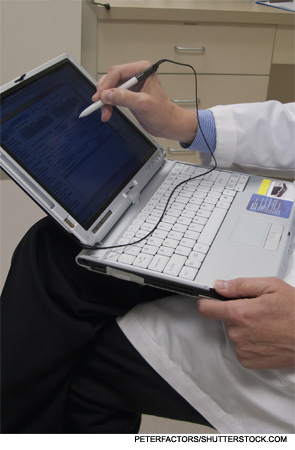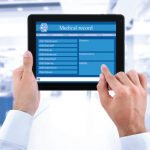
As electronic health records (EHRs) become ever more common in medicine, quality communication between clinicians has paradoxically declined. This is evidenced in the challenges experienced in handoffs of clinical responsibility between clinicians, difficulty in communications between inpatient and outpatient providers, and in the decline of meaningful communications between care team members focusing on a single patient within a specific setting of care. The EHR must above all else facilitate clinical communications. A renewal and a transformation of the busy clinician’s capacity to record and to understand clinical information within EHRs are needed.
Electronic vs. Paper Records
EHRs and legacy paper clinical records differ in multiple, fundamental ways. The first of these is that there is a presumption of many providers using the same EHR record. The distribution and availability of the EHR is limited only by the technology of electronic distribution and whatever limitations are needed to secure privacy and security. The paper record is constrained by its physical possession. The EHR is a comprehensive record of the patient’s care, including many items of little interest to the clinician; the paper record is generally dedicated to a clinical narrative. This in turn has led to confusion and likely a transition in the notion of who owns the medical record and for what purpose it is to be used.
These differences may be further characterized in the following manner:
Paper: 1) Physical possession, with little presumption that the available physical chart was, in fact, complete; 2) cryptic, often unreadable notes; with 3) information typically disorganized from reviewers’ perspectives. We argue this led to more personal communication among providers, at least for more complex and seriously ill patients.
EHRs: 1) Observations are more likely to be taken as fact (data) when they appear on a computer screen or a printed page; 2) they are presumed complete and comprehensive, and, therefore, the omission of critical information (in a note, lab or imaging report) suggests the observation has not been made. 3) Readers tend to imbue critical utilized terms with personal meaning; for example, if an electronic chart states the patient is allergic to ibuprofen, the physician likely presumes that means a proven IgE-mediated event, yet a major EHR codes “intolerance” as a type of allergy. 4) Despite these risks, EHRs do offer the opportunity to improve coordination of care among patients, primary care physicians and specialists via near instantaneous sharing of information. 5) Additionally, EHRs provide enormous opportunities for clinical decision support—from drug interaction and allergy warnings to medication calculations and preventive, as well as high-risk, care alerts. 6) With the potential for standardizing care and identifying small patient cohorts among providers and centers, EHRs also offer the promise of improving population health through collaboration and research. That said, many promised EHR benefits do not directly improve the care of healthy persons, nor those with common, acute and transient illness.
Paper medical records traditionally were designed to reflect the clinical history and plan for the patient’s care. However, because billing requirements forced written documentation of all historical and observational elements personally done by the billing provider, detailed differential diagnoses and discussion largely disappeared from paper records, as did explanations for treatment recommendations and plans. When electronic records entered clinical workflow, they quickly became excellent tools for billing documentation. Indeed, billing documentation has now become one of the most important functions of the EHR, with many products striving to provide tools to enhance payment rates. This in turn has led to many automated features for clinical documentation whose sole purpose is to enhance billing efficiency. Many of these are automated features that are repetitive, redundant and irrelevant to the patient’s care, serving as barriers to clinical communication. Perhaps this was inevitable for an industry whose business model is based on transactions rather than outcomes.
The federal Meaningful Use and Value-Based Modifier Programs are initiatives to move transactional payment-to-value assessment for Medicaid and Medicare patients. However, the quality measures used in these programs remain crude and are not yet harmonized. Moreover, we remain focused on process improvements (such as DMARD prescription for RA patients), rather than quantitation of RA-associated disability and work loss. The certified EHR, accompanied by defined and standard terminologies, such as RxNorm, SNOMED and LOINC, is the key tool of these public (and many private) payer programs.
Drawbacks
We argue that the forced focus of EHR vendors and care providers in meeting these requirements has serious adverse effects, even though many requirements, such as exceptional EHR tools for patient engagement in care, are intrinsically valuable. For example:
- Today’s EHRs do not auto-adapt to the workflows of individual clinicians, and not surprisingly, EHR use is non-intuitive for many. That can mean increased work hours and/or decreased patient access, and paradoxically poor regulatory program “performance.” To wit, recent reports suggest that physicians are retiring earlier, and increasingly refusing to accept new Medicare patients in their practice.
- Focus on tracking discrete data elements has sacrificed the nuance and meaning that narrative may contain.
- “Copying forward” past observations into a current note has (somewhat) addressed billing requirements, but in so doing, increased the risk of medical error and in the plagiarism may in fact stretch common sense standards of ethical propriety and rigorous standards of compliance legality.
- “Copying in” large amounts of data into documentation risks both irrelevance and “note bloat,” diminishing its value to other providers and, therefore, the patient’s healthcare.
- The promise of clinical decision support in EHRs is often operationally diminished by the flood of alerts providers may experience, with the critical alert drowned out by the irrelevant.
Improvement Potential
The good news: EHRs could be built to address most of these concerns.
- There is great opportunity for enhanced focus on usability and, more specifically, decreasing clicks, integrating workflows and suggesting documentation tools based on past utilization. Depending on circumstance, and even by the same provider, some documentation is best done by flowsheet, others by form or template, still others as brief typed notes or dictation. Therefore, there is no ideal rheumatology documentation tool right for every rheumatologist (although we’ve seen some real progress).
- Highly accurate integrated voice recognition could be more widely disseminated (already here: “Cloud Dragon” requires no voice profile and is about 99% accurate).
- Advanced natural language processing has the opportunity to pull discrete information from narrative in real time.
- Vendors could incorporate metadata tagging of historical and observational data in terms of reliability, displaying a scale for presumed reliability of the observation. For example, reliability of observation of a small knee effusion in a crying, struggling, pudgy 2-year-old child.
- We could develop tools for graphical and/or tabular display of any data element by patient and provider population, real time, at provider request.
- There should be no need for the note creator to order data elements in SOAP, APSO or any other format—because the EHR should present information from the note according to the desires of the reviewer, while of course keeping the original signed version. For example, the consulting nephrologist, neurologist and cardiologist will each look for different emphasis and detail in the comprehensive rheumatology note of an admitted lupus patient with Type IV GN, seizures and pericardial effusion.
- User-defined alert levels and detail could minimize the alert bloat that is so common.
- With a focus on user needs, optional data presentation pertinent to the provider could be provided, tailored to the patient’s diagnosis. For example, a rheumatologist might order a CBC, CMP and UA as a safety check for an RA patient on methotrexate and naproxen, and these data might be presented showing Hgb, WBC, platelets, Cr, AST, ALT, LDH, urine protein and blood, plus additional results if abnormal.
- Clinical decision support for critical medical terms could be created, for example, advising the provider when diagnostic criteria are met (and not met). Today’s EHR uses standard terminology, but does not standardize its use. Although medical terminology a generation ago was largely private to the physician, today it’s the basis of procedure approval, billing, the onramp for the patient to learn more on the Internet, and also the primary communication tool between providers—some “a world away” in another emergency department.
- We can further refine superior search capabilities to focus on more relevant information elements.
There is no ideal rheumatology documentation tool right for every rheumatologist (although we’ve seen some real progress).
Added Features
The EHR has led to additional features and problems in comparison with paper clinical records. The first is the nonstandard clinical vocabulary, which characterized the paper electronic record. How many terms have been used to describe the concept of heart failure? The EHR has the capacity to constrain standards of vocabulary, whereas a blank page has an infinite capacity for diverse terms to describe clinical situations.
Another challenge (or opportunity for billing) is that the EHR has the ability to compel more thorough documentation; paper records have been subject to tremendous user variability, at times characterized more by brevity and superficiality than completeness and relevance. Clinical decision support, the exclusive domain of the EHR, may remain the greatest disappointment in modern EHRs—the promise of its fulfillment still tantalizing many.
Lawrence Reed initiated a movement in the 1970s to standardize clinical documentation in the paper record. His legacy is still apparent in the frequent use of the assessment and plan portion of contemporary EHRs. But the classic Weed SOAP note, consisting of the subjective, objective, assessment and plan, is rarely used. There is also a growing disparity between inpatient and outpatient documentation in its depth and comprehensiveness. Added to this is the automated addition of largely normal laboratory, radiographic and other prior information, which has led to bloated notes, in which it can be difficult if not impossible to understand precisely what the clinician is thinking about the patient’s problem, what interventions might be planned or why.
Contemporary EHRs increasingly have sacrificed narrative for succinct and standardized vocabulary. Traditionally, the history of the present illness was the patient’s story as he or she experienced it, at times modestly edited by the clinician for relevance. Similarly, the assessment and plan were the clinician’s story, relating his understanding of the clinical problem and his plans for addressing it. Both of these at their best are stories, with all of the richness of vocabulary and nuance of expression of the individuals involved.

Increasingly, clinicians find it difficult to allocate sufficient time for detailed documentation of clinical activity. Drop-down fields have improved efficiency, while sacrificing the richness of vocabulary apparent in the well-crafted narrative. This has led to potentially dangerous difficulties in communication between clinicians; the medical record has increasingly bowed to the needs of documentation for billing, with the sacrifice of clarity and weighting of relevance in the characteristics of clinical care and the planned course of action.
A number of opportunities exist that would greatly enhance clinical communication, as well as recognize the tremendous demands on clinician time and energy.
Voice recognition is becoming a mature technology that affords much greater efficiency and clarity in the input of the clinical narrative. One product even has the capacity to use natural language-processing techniques for real-time data extraction, potentially fulfilling multiple demands with the same tool. Typing, or keyboarding as it is more commonly described, has the capacity for fairly rapid input if sufficient skills have been acquired by the clinician. Both of these tools have the capacity to return to the clinician the richness of vocabulary and thought that is slipping away in contemporary EHRs, at the cost of increased demand on time. Patient-entered information also has great potential, if technologies can be developed to refine both relevance and accuracy. Improved structured data input constrained by predefined fields of information has the potential for tremendous benefit, although it will likely always lack the richness of narrative vocabulary.
Most current efforts at improving clinical communication in the EHR have focused on varying methods of input by the clinician. A new way of thinking might be to focus on different presentations of the clinical record based on the viewer’s function. The same medical record might have a very different view of the record for a billing or administrative role than it might for a clinician role. In this manner, comprehensive information would be available in the EHR, but increasingly there would be different views of the aggregate information based on the function of the reader. This could go a long way toward removing the extraneous information that is such a burden to all.
Moving from SOAP notes to APSO notes, in which the clinical summary appears at the beginning rather than the end, could provide more rapid assimilation of information by subsequent clinicians. This also might lead to greater functionality in both inpatient and ambulatory settings, by providing more information that is germane to the setting at hand. The complexities of the acute care setting with its reliance on frequent data access have little relevance to subsequent care in the ambulatory setting. There needs to be better focus on the workflow of clinicians. Where is the information required to make clinical decisions, and how can it be more meaningfully presented?
There is a compelling need for the more intuitive presentation of clinical information, particularly laboratory, radiographic and pathologic information. At the very least, there should be the capacity for rapid distinction of significant abnormal results from repetitive normal results. How many normal mammogram reports should be viewed to find the one that is abnormal? Superior search capabilities to identify abnormal results would seem to be a real opportunity.
The Bottom Line
EHRs have enhanced many aspects of clinical documentation, including rapid dissemination, distribution and engagement by multiple providers, as well as patient engagement in portions of the clinical record, enhanced billing documentation, and a potential capacity to enhance overall efficiency of documentation. But in recent years, the EHR has moved from a narrative, which served the needs of patients and clinicians to have a longitudinal record of the patient’s care, to a document that is primarily designed to serve administrative needs. Many clinicians now find it difficult if not impossible to go to the EHR and to answer the crucial questions regarding what is the patient’s problem and what is planned to address this problem. And that must remain the most important function of any record of a patient’s care.

